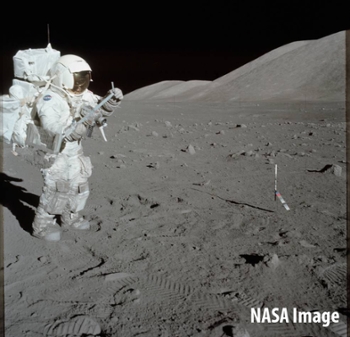Dr. Thompson to Investigate Untouched Apollo Samples
04-16-2019
Writer(s): Logan Judy

While much attention is sometimes given in planetary research to the possibility of returning samples from new celestial bodies, one of the great opportunities for research actually comes from the past. Many samples taken from past missions, including those from the Apollo program to the Moon, were vacuum sealed and never exposed to Earth’s atmosphere.
This is done intentionally, so that future generations can continue to study lunar samples and benefit from the missions. In many cases, new analytical methods are developed that can maximize the usefulness of the samples. In a new research opportunity, NASA is making multiple lunar samples available to a total of nine teams to investigate, awarding $8 million dollars in research funds. These have been untouched for nearly 50 years. Dr. Michelle Thompson, who is involved with one of these teams, said this is a great opportunity for multi-generational scientific collaborations.
“For the first time, we have new samples available to scientists who weren’t even born when these missions returned samples,” Dr. Thompson said. “This gives them the opportunity to work together with the senior scientists in the field, many of whom have been working on lunar samples since the return of the Apollo missions. “
The sample Dr. Thompson will be working on is a rock core sample, extracted not just from the surface but from the top sixty centimeters of the Moon. It comprises approximately 1.8 pounds of material, extracted during the Apollo 17 mission, which came to Earth vacuum-sealed and has been in that state ever since. She and her laboratory will be looking at their microstructural features, which can give clues as to how long individual grains spent on the uppermost surface of the moon, exposed to interplanetary space.
“If we can identify microstructural differences between the samples from different depths of the rock core, that gives us information about the soil material, and how rocks are being broken down and cycled around in that upper meter or so of the Moon.”
This is a rare opportunity for investigation, as there are very few samples from the subsurface of the Moon – most samples come from the Moon’s surface. In this exploratory study, there are also opportunities to better understand how volatiles like water may be trapped or are transported across the surface. This becomes more relevant as we grow closer to human expansion, as we can better analyze the presence and location of water on other celestial bodies, which has implications for manned missions.
These opportunities are exciting, but also carry with them a host of logistical challenges. Because the samples have been frozen or stored in helium for multiple decades, there’s a danger of exposing them to Earth’s atmosphere, thus contaminating them and changing experimental results. In some cases, multiple teams will be working with a single sample, further increasing the logistical challenges of the project.
“These samples have been specially curated,” Dr. Thompson said. “Now that all of the teams have been selected, we have to coordinate the operation, and figure out how do we preserve the material in its specially-curated status, but make it available for analysis by all of the teams. We will all work together to solve these challenges.”
Pieces of the material will be sent to other labs, and some of the research will take place at the NASA Johnson Space Center in Houston, where there will be collaborative research spaces for the teams to utilize. The primary investigator of the team Dr. Thompson is working with is Dr. Chip Shearer of the University of New Mexico. Other collaborators include the University of Arizona, the Bay Area Environmental Research Institute, the University of California Berkeley, Mount Holyoke College, the Planetary Science Institute, and the U.S. Naval Research Laboratory, as well as multiple NASA laboratories.